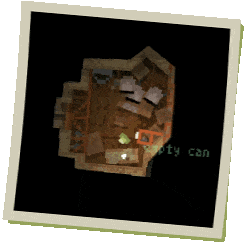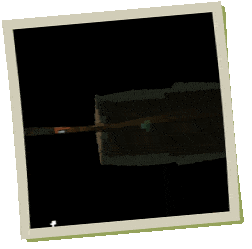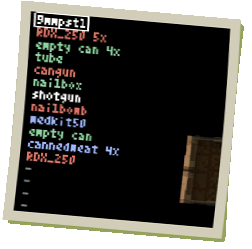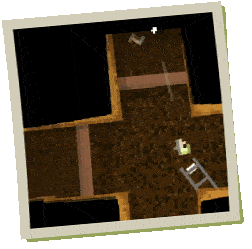 31/39
31/39Table of Contents [Show]
Teleglitch: Die More Edition Review
August 21st, 2021
Coming from someone who absolutely despises horror games, Teleglitch has to be one the most enjoyable Indies I have ever had the pleasure of recommending. This may sound like hyperbole considering the game's arguably outdated aesthetic, however the engaging combat, coupled with the clever sound design, random level generation, and captivating lore have steadily kept me coming back to this game throughout the years.

In this top-down, story-driven Roguelite, you are put in the shoes of a Militech scientist stranded on an Earth-sized planet dubbed "Medusa-1C". With the central AI having gone rogue and other inhabitants killed, your sole mission has become survival. Unfortunately, the automated supply chain was stopped dead in its tracks and you've ran out of food, forcing you to leave shelter in an attempt to find out what happened for yourself.
The intro, loading screens, and computer terminals scattered around each stage provide different pieces of storytelling in an intuitive and coherent manner across different playthroughs, eventually helping the player piece together a series of events that led to the situation they are facing. Each area has its own designated lore piece, with some miscellaneous and fun tid-bits sprinkled in-between.
Logs will go on to reveal the planet served as a research facility for the development of long-range teleportation, combatant AI, and plant-based soldiers; they will document the inhabitants' routines, schedules, scientific findings, and other aspects of day-to-day life. You will often find notes describing mutated lifeforms and plants, reports on interactions between test subjects and staff, diary entries expressing enthusiasm or concern towards the research in the facility, as well as note and warning exchanges between fellow coworkers.
Various findings will use pseudo-scientific jargon to help involve the player with the game's world as well as give the impression the events are based in a futuristic, dystopian reality. Science pet-projects (unbeknownst to their author at the time) will provide the PC with recipes for weapons, armor, and equipment later on. Log entries will also hint at the existence of secret rooms and supply depots waiting to be exploited by the player.
This allows the game to engage in some incredible world-building, where terminals serve as a remnant of a once peaceful life characterized by rapid technological advance. You see a subtle, yet gradual spiral out of control, a reality where questionable ethics and a general lack of care for human life run rampant. In contrast to that, the personal diary entries of the scientists are a great display of humanity, in a place no longer inhabited by humans - an insight into what life on a military research facility was once like.

Let's talk game mechanics. One decision critical to the success of Teleglitch as a horror game was limiting the cone of vision to what the character can see in real time, despite the consistent top-down perspective.
Players are not able to see behind closed doors and solid walls, rewarding caution and inciting mild feelings of paranoia. The camera zooms in on the player and shifts away whenever they enter or exit a tight hallway, creating tension and uneasiness.
Enemies are then deliberately designed to be melee-based creatures, aggressive and agile, small in size. This makes such an environment not only suffocating but also incredibly dangerous to move in. Dynamic objects, to the likes of crates and tables, will potentially slow down the player's retreat.
The fog-of-war and camera perfectly fit the way the world is designed, helping contrast the narrow hallways with the more spacious, deceivingly comforting rooms - that are reserved for larger fights and boss battles, as the players quickly find out.
The next step in the process was to exclude any and all background noise from the game, leaving the many ambient sounds present in it to set the atmosphere instead. Power generators make a loud and steady, almost unsettling humming sound. Flickering lights emit an eerie crackle. The scientist's footsteps echo through the dark, seemingly endless hallways. The occasional, sudden realization that the footsteps echoed back at you are not in fact yours, makes for a terrifying yet enjoyable playing experience.
Sounds of gunfire and explosions are also a great shift from the constant, near-deafening silence of Teleglitch. This is helped by the screen distorting upon each fired shot, as if the scientist himself is fazed by the recoil. Your firearm feels effective as a result, each shot feels like it has force behind it. Most ranged weapons are inaccurate, again encouraging you to conserve ammo and engage enemies from up close. Panicking and wasting precious ammunition will impede progress further down the line.

Teleglitch also features an inventory system that allows for the collection of scrap metal and parts, resulting in the crafting of new gear and weapons.
The items in your inventory are color-coded to represent respective roles, and can be moved with an assigned combination of keys freely, which I appreciate. Crafting items is streamlined to be quick and easy - pressing 'C', selecting a result from the list, then pressing 'Enter'.
Items consist of no more than 4 ingredients and require no static workstation to build. This is the 'survival' aspect of the game - collecting scrap and quickly crafting supplies on the go. Crafted items are significant and will make the game much easier. The new weapon variants may behave differently (when not acting as direct upgrades), but aren't mandatory since most are found in the form of natural loot anyway.
Combat was incredibly enjoyable for me. Enemies have a consistent amount of HP yet are fast and unpredictable; they get knocked back and bleed whenever you hit them, providing satisfying feedback for your action. The aim reticule is aligned to your currently-held weapon rather than the center of your person, increasing the amount of skill required of you to utilize it at point blank range.
The weapons can be upgraded to be more CQB-oriented, at the expense of long range accuracy; the 9mm pistol can be wired to fire in full auto, the shotgun can fit another barrel to fire twice the ammo, the revolver can be upgraded to fire all shots at once, and more. A ranged weapon is not the only tool at your disposal; you have an upgradeable melee weapon, explosives, traps, and environmental warps to lead enemies into.
Pre-built sections of the level are connected in seamless, almost unnoticeable patterns. Light sources cast shadows onto the many plants and machines that break the monotony of the rusty metal-plated walls in the facility. Stages contain a multitude of small details, to the like of broken fencing, convoluted piping, control panels, barrels filled with unrecognizable liquid, respective furniture in offices and dorms. The player will oftentimes walk under scaffoldings and trees, giving the top-down perspective a newer sense of scale and depth.
I can appreciate a developer who not only skillfully creates art, but also fully commits to certain themes. Text is all lowercase, looking as if it was written into a command line; the loading screen of the game itself looks like a game being launched from a DOSBox. Item names are condensed, as if to conserve space. Not many games are able to nail this sort of retro aesthetic down, but I feel this game gets it.

Perhaps the weakest link in Teleglitch's design is its meta-progression system. You unlock new weapon recipes (which are permanently memorized from there on out), monster logs, and stage shortcuts.
You don't unlock new items, areas, weapons or characters. You also can't find interactable NPCs or entities that aren't computer terminals or door switches. I understand the game likes to fall back on minimalism, but there aren't many reasons to replay it.
It is truly impressive to see how a bunch of pixels can incite such strong feelings of paranoia and anxiety in you given the right setting. There's great joy in immersing yourself in such a well thought out world, and a great sense of accomplishment in rising to the occasion through random scrap you found around the stage.
A great little horror game and a well-designed Roguelite. Highly recommended for the eerie (if not for the little short) playing experience.